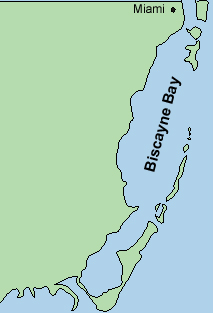|
Biscayne Bay is home to a wealth of biological species including the protedted manatee and an endangered species of seagrass. There are a large number of boaters who regularly sail on the bay or tourists and local residents who sun bathe on its shores. It is also an excellent source for fishing including the commercially important pink shrimp. The locality of the bay exposes it to a number of seasonal meteorological phenomena, most noteably hurricanes. "Biscayne Bubbles" provides an introduction to these types of facts as well an overview of the local research conducted by NOAA, the University of Miami's Rosenstiel School of Marine and Atmospheric Science, and Florida Sea Grant. To view the Bubbles, simply click on a title below. The series are reproduced in their original pdf format. If you do not have Adobe Acrobat Reader, please click here to down load a free version.
|

 The
Miami
area is a fast growing urban environment in close proximity to fragile
coastal ecosystems, in particular, Biscayne Bay. To help those that
live on and near the bay learn about it's many biological, chemical,
and physical characteristics, the local Key Biscayne newspaper, The
Islander, teamed up with the Virginia Key Science Community to produce
this educational series, "Biscayne Bubbles". The Bubbles series,
originally published on a weekly basis in the The Islander, is
now available to view on line. It is modeled from a similar publication
focused on Long Island Sound titled "Sound Facts".
The
Miami
area is a fast growing urban environment in close proximity to fragile
coastal ecosystems, in particular, Biscayne Bay. To help those that
live on and near the bay learn about it's many biological, chemical,
and physical characteristics, the local Key Biscayne newspaper, The
Islander, teamed up with the Virginia Key Science Community to produce
this educational series, "Biscayne Bubbles". The Bubbles series,
originally published on a weekly basis in the The Islander, is
now available to view on line. It is modeled from a similar publication
focused on Long Island Sound titled "Sound Facts".